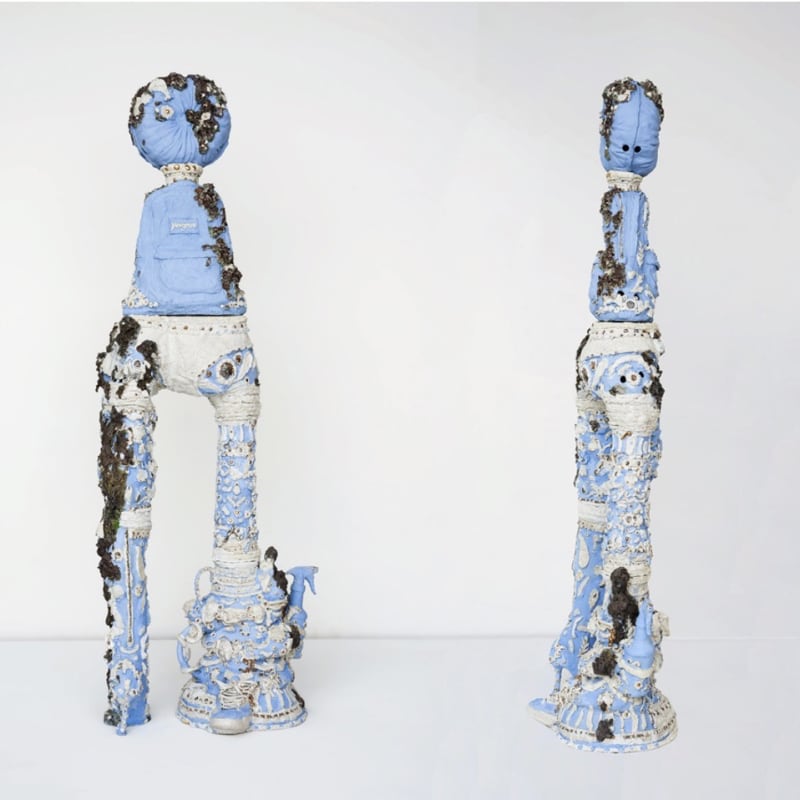'Dizzylingly acrobatic and refreshingly non-hierarchical', Francesca DiMattio's work turns all the aesthetic associations of porcelain on their head. Now, with her latest immersive exhibition, the artist invites viewers into a space brimful of coralline curlicues and Maximalist mayhem.
Francesca DiMattio is interested in opposites. Her home in the rolling green of Hillsdale, upstate New York, for instance, is no gabled clapboard cottage, but a corrugated monolith of matte-black steel. It’s a surprising setting, perhaps, for an artist creating work here that deals with ideas of femininity, history and domesticity – particularly for those familiar with her infinitely more baroque set-up in Manhattan (WoI Oct 2022). Then again, perhaps it’s not. DiMattio’s large and lustrous china-patterned caryatids, teetering towers of teapots, swarming floral fireplaces and encrusted stiletto boots all speak to the frictions that exist between womanhood, beauty, strength and power.
These same struggles form the fuel for a new solo show at Pippy Houldsworth Gallery opening this autumn – the artist’s fourth at the London exhibition space. Comprising an array of tumultuous ceramic assemblages, the show will be set against a backdrop of wallpapers and a trompe-l’oeil flooring designed by DiMattio as an immersive installation of maximalist sensibilities.
Evidenced by everything in the exhibition, DiMattio’s aptitude for referencing is encyclopaedic, dizzyingly acrobatic and refreshingly non-hierarchical. There may be, on the surface, a Rococo-inflected whimsy to her pairing of a Bauhaus T-shirt, say, with Roman mosaics and Greek black figure pottery, or a football with snorkelling mask, but in fact these mishmashes dismantle the exclusivity of the high-low dichotomy that many still seem to set store by.
One of DiMattio’s great skills lies in her ability to use this hyperbolic hybridity to compress centuries’ worth of time and bring it into the here and now, relying on other similarities to help make sense of what we see. When the biscuity blue of 18th-century Jasperware – the globally successful brainchild of Josiah Wedgwood, often seen as history’s first tycoon – is made as rarefied, recognisable and worthy of inclusion as a trigger-levered spray bottle of cleaning fluid, of the kind hidden in billions of kitchen cupboards around the world, which matters more?
It should be pointed out that there is a playfulness that runs through DiMattio’s work, and not just the charismatic chaos of her clustered ceramics. The artist’s plasticity of scale, for instance, again pokes fun at ideas of aesthetic acceptability. In Sèvres Converse, delicate motifs of the finest pink French porcelain are transmogrified into splashy repeats to cover the trainer-topped piece’s plinth, losing none of their prettiness in the process. Other works are encrusted in blackened, barnacle-like blobs, like so many sunken treasures dredged from shipwrecks, albeit featuring decorated trainers, flower-dotted backpacks or underpants: a tongue-in-cheek contrivance of age and implied gravitas.
In her creation of these new forms, liberated from any orthodox notions of cultural or canonical cachet, DiMattio presses us to find new meaning – to look for beauty in the big and overblown. It’s a reminder that the most exquisite jewels are often to be found in unexpected places.

